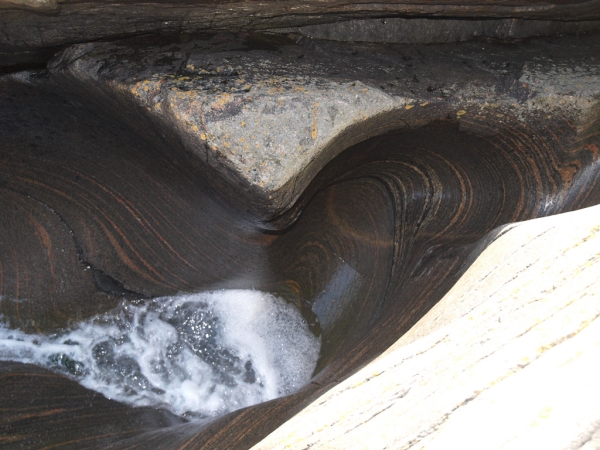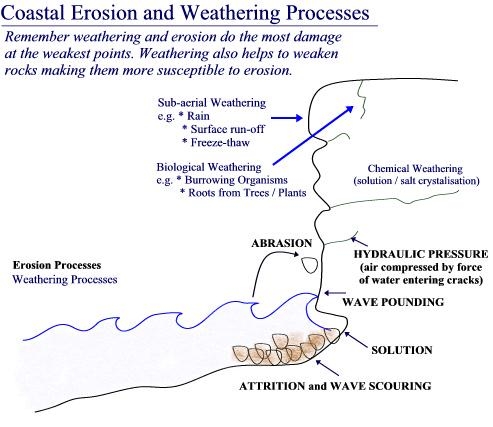Bua Beach Kettles EarthCache
-
Difficulty:
-

-
Terrain:
-

Size:  (other)
(other)
Related Web Page
Please note Use of geocaching.com services is subject to the terms and conditions
in our disclaimer.


För att få en godkänd logg måste Du svara på frågorna nedan
INNAN loggning.
En jättegryta är en fördjupning i ett berg, bildat genom att
strömmande vatten fått en större sten tillsammans med grus och
mindre stenar att rotera runt i en virvel under lång tid. Många
stora jättegrytor skapades under istiderna genom att en större sten
roterades med framforsande smältvatten tillsammans med grus och
mindre stenar längst ner mot glaciärens botten. Stenen som har
bidragit till jättegrytan ligger oftast kvar i botten än i
dag.
”jättegryta, hål i fast berg eller lösa block, bildat genom
naturliga processer. Grytorna är runda till ovala i tvärsnitt och
kan bli flera meter breda och djupa. Man kan urskilja fyra olika
slag. Älvgrytor bildas i vattenfall eller forsar. Glaciala
jättegrytor har bildats under inlandsisen med hjälp av starkt
strömmande smältvatten som satt stenar i rotation. Strandgrytor har
skulpterats ut av havsvågor med hjälp av strandklapper.
Vittringsgrytor är vanliga i graniter och sandstenar i hela
världen. Vittringsgrytor finns i s. Sverige. De bildades där under
krittiden och finns ofta i anslutning till fast anstående
krita.” (NE)
Maila svaren till mig INNAN loggning.
1. Hur tillkommer grytor som denna oftast?
2. Vad kallas den process som bildar grytor?
3. Mät djupet på Bua Strand Grytan.
4. Tag ett fotot på dig själv och GPS vid grytan och lägg i Din
logg. (frivilligt men uppskattas)
Information kan hittas här och
här


To get an approved log You need to email me the answers on the
questions below BEFORE logging.
A pothole is a recess in a mountain formed by flowing water had a
larger stone with gravel and small stones to rotate around in a
vortex for a long time. Many large potholes created during the ice
ages by a large stone was rotated with the rushing melt water along
with gravel and small stones at the bottom of the glacier bottom.
The stone, which has contributed to the giant cauldron is usually
left in the bottom than at present.
A Giant's kettle, also known as giant's cauldron or pothole, is a
cavity or hole which appears to have been drilled in the
surrounding rocks by eddying currents of water bearing stones,
gravel and other detrital matter. The interiors of potholes tend to
be smooth and regular, unlike a plunge pool.
Potholes vary in size from a few inches to several feet in depth
and diameter. They most commonly occur in shields, where there are
ancient rocks (granite, gneiss) with different resistances to
erosion, so strong pebbles can fall into small cavities in stream
bottoms and swirl, making the cavities wider and deeper. The
hardness of the pebbles must be the same or higher than the rock at
the bottom of stream where the kettle is forming. In areas where
there are diamonds and quartz pebbles, the hardness of these carve
potholes and sometimes remain trapped in the bottom of them. That
is why these potholes are a good place to find diamonds (the
hardest natural mineral on Earth).
Giant's kettles can also be formed while the surface is covered by
a glacier. Water, produced by the thawing of the ice and snow,
forms streams on the surface of the glacier, which, having gathered
into their courses a certain amount of morainic debris, finally
flow down a crevasse as a swirling cascade or moulin. The sides of
the crevasse are abraded, and a vertical shaft is formed in the
ice. The erosion may be continued into the bed of the glacier; and,
the ice having left the district, the giants kettle so formed is
seen as an empty shaft, or as a pipe filled with gravel, sand or
boulders. Such cavities and pipes afford valuable evidence as to
the former extent of glaciers.
Similar holes are met with in riverbeds at the foot of cascades,
and under some other circumstances.
Mail me the answers BEFORE logging.
1. How does kettles like thees arise?
2. What is the process that creates thees kettles called?
3. Measure the depth of the Bua Beach Kettle.
4. Take a picture of You and Your GPS at the Bua Beach Kettle.
(optional but appreciated)
Information can be found here and
here

Additional Hints
(No hints available.)